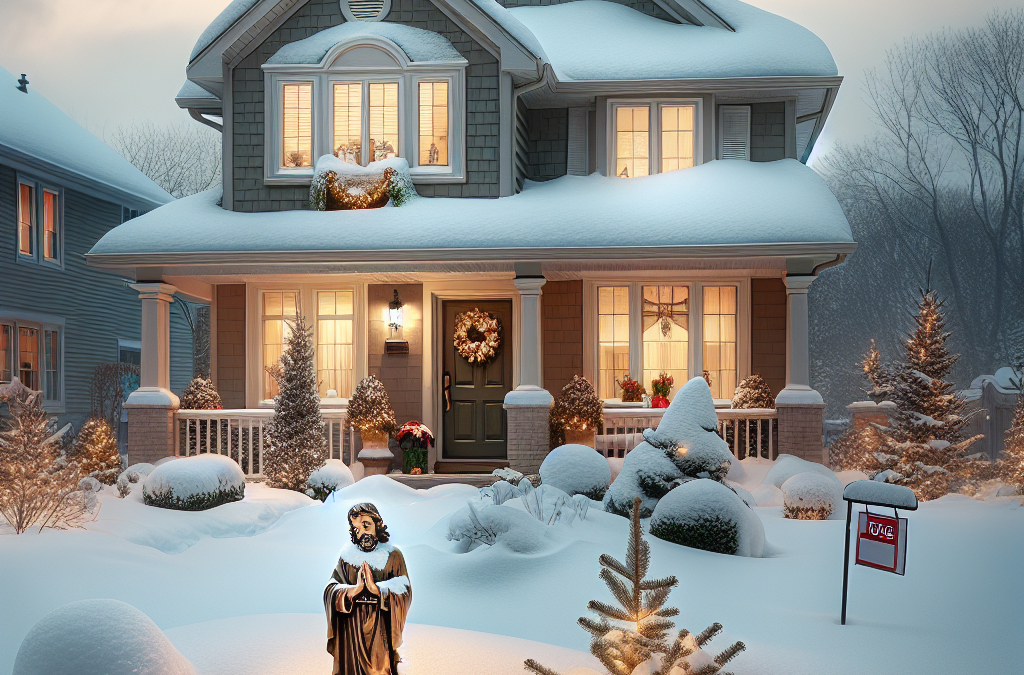
Real Estate
The US Masters Residential Property Fund (ASX: URF), a specialized investment trust focused on residential properties across the United States, has made a notable announcement concerning its ongoing Market Buy-Back Program. This update comes as a strategic move to deliver value to its shareholders while navigating the dynamic real estate investment market. Here’s everything you need to know about the recent developments and the potential implications for investors.
What Is a Buy-Back Program?
Before diving into the specifics of US Masters Residential Property Fund’s (URF) announcement, let’s first understand the concept of a buy-back program. A buy-back program, often referred to as a share repurchase, is when a company or fund buys back its own shares from the marketplace.
So why do companies undertake buy-back programs?
- Boost shareholder value: By reducing the total number of outstanding shares, earnings per share (EPS) typically increase, which can drive up the stock’s value.
- Show confidence: A buy-back signals to investors that the company believes its shares are undervalued.
- Enhance capital management: Companies with excess cash often opt for buy-back programs to reinvest in themselves rather than seek external growth opportunities.
For funds like URF, buy-back programs represent a focused effort to create shareholder value in an industry that relies on property market performance.
US Masters Residential Property Fund’s Latest Update
In the recent announcement, US Masters Residential Property Fund confirmed its **continued commitment to executing its ongoing Market Buy-Back Program**. The fund detailed its intentions to actively acquire its own shares on the open market, signaling confidence in its portfolio’s intrinsic value and long-term growth potential.
Specifics of the Announcement
Here are the key highlights from the fund’s update:
- The buy-back aims to address the disparity between the fund’s underlying net tangible assets (NTA) and its market valuation.
- The program focuses on the strategy of repurchasing shares in a manner that maximizes capital efficiency while being mindful of property portfolio liquidity levels.
- This ongoing initiative is part of a broader effort to drive better returns for investors by optimizing the capital structure.
This announcement aligns with URF’s broader investment philosophy of focusing on high-quality, blue-chip residential properties in the U.S., with a particular emphasis on the New York metropolitan area.
What Does the Buy-Back Mean for Shareholders?
The buy-back program carries several implications for existing shareholders, such as:
- Increased Ownership Stake: As the fund reduces the number of outstanding shares, existing shareholders gain a larger proportional stake in the fund.
- Potential for Share Price Growth: A buy-back often reduces market supply, which can drive up demand and share prices over time.
- Improved Market Perception: Buy-backs often indicate that the company believes in its fundamental value and prospects, enhancing investor confidence.
For URF, this move might be a signal that management believes its shares are significantly undervalued by the market—a sentiment worth noting for current and prospective investors.
Why Now? The Strategic Timing of the Buy-Back
The decision to continue with the buy-back program comes at an interesting time, as the global real estate market continues to grapple with economic uncertainties and fluctuating interest rates. Here are a few reasons why this timing makes strategic sense for URF:
Addressing NTA Discount
Like many property funds, URF may find itself trading at a discount to its Net Tangible Assets (NTA). This gap often arises when the market undervalues the fund’s actual property holdings. By initiating buy-backs, URF aims to shrink this discount and better align its share price with its net asset value.
Stabilizing Investor Sentiment
Real estate as an asset class has faced challenges due to rising interest rates, inflationary pressures, and a competitive rental market. In this context, URF’s buy-back program demonstrates the fund’s proactive efforts to stabilize investor sentiment and reaffirm its confidence in the residential property market.
Proven Track Record of Success
URF has a history of using strategic measures to improve its performance. Past initiatives, including portfolio optimization and debt management, have set the stage for this latest step in enhancing investor returns.
The Bigger Picture: Residential Property in the U.S.
While the buy-back program is crucial in maximizing investor returns in the short term, it’s also a reflection of URF’s broader strategy of capitalizing on the resilience of U.S. residential real estate. Here’s an overview of the market backdrop that may be driving the fund’s confidence:
- Demand for Housing Remains High: Despite headwinds in the global economy, record-low housing stock in the United States has created a persistent buyer and renter demand.
- Steady Rental Yield Growth: Residential properties in New York and similar metro areas continue to generate desirable rental yields, supporting long-term cash flow for property funds.
- Resilience Against Economic Shocks: Historically, residential property markets in prime locations have shown resilience against economic downturns.
URF’s focus on residential portfolios, especially in one of the most in-demand metro markets, positions it to ride the wave of strong housing demand and rental growth.
What Investors Should Watch Moving Forward
The continuation of URF’s buy-back program raises several key considerations for those invested in the fund or thinking of adding it to their portfolio:
Performance Metrics
Investors should monitor how the share buy-back influences key metrics like the Net Tangible Asset per share (NTA/share), on-market trading volume, and share price movement over the coming months.
Portfolio Updates
As always, URF’s performance will hinge on the strength and stability of its property portfolio. Investors should stay updated on acquisitions, market conditions, and any asset re-valuation.
Market Trends and Interest Rates
Continued pressures from rising interest rates could influence the broader real estate market. Investors should monitor how URF navigates these shifts and balances its debt obligations.
Conclusion
The US Masters Residential Property Fund’s decision to continue executing its buy-back program is undoubtedly a positive development for shareholders and a clear indication of the fund’s proactive management style. By reducing share supply and capitalizing on undervaluation, URF aims to create long-term value for investors in a challenging real estate environment.
For investors looking to maximize their exposure to high-quality U.S. residential property with a blend of growth and dividend potential, URF remains a fund worth watching. Stay tuned for further updates as the buy-back program progresses and market dynamics evolve.

Real Estate
The luxury real estate sector is off to a historic start in 2024, as high-end home sales across the United States reach unprecedented levels. Wealthy buyers are fueling the demand for opulent properties, setting the stage for a record-breaking year in extravagant housing. With significant transactions in cities like Los Angeles, New York, and Miami, the battle for exclusive addresses continues to intensify. Here’s an in-depth look at the booming 2024 luxury housing market and the key factors behind its growth.
What Defines a Luxury Property in 2024?
In the elite world of luxury real estate, exclusivity and bespoke details reign supreme. A property must exhibit certain qualities to qualify as “luxury.” In 2024, such properties are characterized by:
- Prime Location: Proximity to cultural, architectural, or natural landmarks remains a determining factor.
- High-End Amenities: Think private spas, infinity pools, large wine cellars, and cutting-edge home automation systems.
- Generational Appeal: A focus on craftsmanship and timeless designs that retain value over decades.
- Exclusivity: Limited availability in prestigious neighborhoods with high barriers to entry.
These elite homes cater to affluent buyers seeking not only comfort but also status, privacy, and lifestyle alignment.
Top High-End Home Sales in 2024
The opening months of 2024 have already seen several jaw-dropping transactions, shattering national and regional records. Below are some of the most talked-about sales so far:
1. Los Angeles Mansion Sells for $200 Million
California’s luxury market has long been the gold standard, and it’s no surprise that Los Angeles claimed the year’s biggest sale to date. A sprawling Bel-Air mansion sold for a record-breaking $200 million, featuring:
- 20-car garage and private airstrip
- Multiple Olympic-sized pools
- State-of-the-art entertainment facilities, including a 50-seat theater
The property’s buyer, an international tech mogul, reportedly purchased the home for a mix of personal use and corporate retreats.
2. Miami Beach Estate Closes at $120 Million
Miami, known for its decadent waterfront estates, saw its priciest residential transaction when a private villa in Star Island exchanged hands for $120 million. This home set an entirely new benchmark with:
- An unobstructed view of Biscayne Bay
- A private dock for a mega-yacht
- Lush, seven-acre grounds with exclusive beach access
With Miami’s increasing appeal to tech entrepreneurs and hedge fund managers migrating from the Northeast, this transaction marks the growth of South Florida’s luxury market.
3. Historic New York Brownstone Fetches $89 Million
Over in New York City, a historic Upper East Side brownstone was sold for $89 million. This property combined old-world charm with modern aesthetics, including:
- Restored period architectural elements, such as original marble fireplaces
- A personal rooftop garden with panoramic views of Manhattan
- Fully upgraded interiors and advanced smart home technology
Buyers are increasingly embracing properties with both historical significance and the conveniences of modern living, a trend that’s turning heads in the Big Apple.
Why is the Luxury Market Booming in 2024?
The explosive growth of the luxury housing market in 2024 can be attributed to several interlinked factors:
1. Increased Wealth Concentration
The world’s ultra-wealthy population continues to expand, driven by gains in tech, private equity, and cryptocurrency investments. This consolidation of wealth is translating into increased spending power in elite housing markets.
2. Demand for Trophy Assets
High-end homes are increasingly seen as “trophy assets” akin to fine art or rare collectibles. They are not merely places to live but statements of affluence and discerning taste. For investors, such properties offer:
- An inflation hedge
- Exceptional resale value
- Global desirability
3. Pandemic-Driven Priorities
The preference for larger homes with private outdoor spaces, driven by post-pandemic priorities, remains a strong influence. Buyers demand sanctuaries where they can entertain, work remotely, and enjoy ultimate privacy.
4. International Buyers
Foreign investment continues to pour into markets like Los Angeles, Miami, and New York. With the U.S. dollar maintaining its strength, affluent international buyers are capitalizing on opportunities to acquire prime American real estate.
The Challenges Faced by the Luxury Market
Although the luxury property sector enjoys unparalleled momentum in 2024, it is not without challenges. Rising interest rates have marginally slowed conventional housing markets, and global economic uncertainty remains a concern. The ultra-luxury market, however, retains a buffer due to its reliance on cash-based transactions and offshore investments.
Additionally, new tax legislation in states like California and New York could impact forthcoming sales. Wealth taxes and increased capital gains taxes may prompt some high-net-worth individuals to reassess future purchases or domicile status.
What This Means for Luxury Realtors
Luxury real estate professionals are adapting their strategies to attract ultra-wealthy buyers. With a focus on digital marketing and tailored experiences, top agents are leveraging technology like:
- Virtual staging and 3D walkthroughs to showcase homes remotely
- Custom apps and CRM tools to manage exclusive clientele
- International partnerships to expand their pool of prospective buyers
Additionally, realtors are becoming lifestyle advisors, assisting clients with everything from private chefs to interior designers to ensure seamless transitions into new homes.
Outlook for the Remainder of 2024
As interest in luxury homes shows no signs of slowing down, experts predict even more record-breaking sales will follow in 2024. Coastal cities like San Francisco and Boston are expected to see increased demand, while secondary markets, including Austin and Nashville, are fast gaining appeal among affluent buyers seeking more space and relative affordability.
Ultimately, the ultra-high-end real estate market reflects the broader wealth shifts currently reshaping the global economy. Whether for investment, lifestyle, or legacy, the appeal of luxury properties will remain steadfast throughout the year and beyond.
Final Thoughts
With staggering price tags and fierce competition, the 2024 luxury real estate market underscores a growing appetite for exclusive properties. From the breathtaking estates of California to the historic charms of Manhattan brownstones, affluent buyers are reshaping the housing landscape one record-breaking deal at a time. As this sector evolves, it’s clear that the luxury housing market will continue to reign supreme as the ultimate symbol of wealth and ambition.

Real Estate
Buying real estate in the U.S. has long been a popular investment choice for both domestic and international buyers. With the winter season underway, this time of year presents unique opportunities and challenges for homebuyers. Whether you’re seeking a vacation property, an investment opportunity, or your future forever home, winter can be a strategic time to enter the market. In this guide, we’ll cover the most essential tips for buying U.S. real estate this winter, helping you approach the process with confidence and efficiency.
Why Winter is a Strategic Time to Buy Real Estate
While spring and summer are traditionally the most active months for real estate transactions, winter can offer distinct advantages to buyers:
- Less Competition: Many buyers hold off their searches during the holiday season and colder months. With fewer people on the hunt, you’re less likely to face bidding wars.
- Motivated Sellers: Homeowners who list their properties in winter may have time-sensitive reasons to sell, such as job relocations or financial needs, making them potentially more willing to negotiate.
- Lower Prices: Due to reduced demand, home prices often stabilize—or even dip—during the winter months, allowing you to score a better deal.
However, the winter real estate market also has its challenges. Limited inventory and unfavorable weather conditions can complicate the process, so preparation is key.
1. Research Regional Markets
The first step to buying real estate in the U.S. is understanding the nuances of the local markets. Unlike other countries, the U.S. market is highly decentralized, meaning factors such as pricing and demand can vary significantly by state, city, and neighborhood.
Key Considerations for Regional Research
- Climate: The winter season impacts regions differently. For example, snowy states like New York or Colorado might see fewer listings, while warm states like Florida or Arizona may see increased activity from “snowbird” buyers.
- State-Specific Laws: Real estate laws and regulations differ from state to state. Research requirements, taxes, and processes in your desired location to avoid surprises.
- Local Economies: Evaluate economic health, job growth, and infrastructure development in the area. These factors can influence long-term property value.
Pro Tip: Use tools like Zillow, Realtor.com, or local MLS websites to compare price trends and availability in your target area.
2. Build a Reliable Team of Professionals
A qualified team of professionals can make or break your real estate experience. Winter markets, with their faster timelines and limited inventory, require a trusted network to ensure your purchase goes smoothly.
Who You Need in Your Corner:
- Real Estate Agent: Choose a licensed agent with expertise in the specific area you’re buying in. They can provide critical insight into market conditions and help negotiate the best terms.
- Mortgage Broker or Lender: Begin with pre-approval for a loan so you know exactly what you can afford. Winter transactions can move quickly, and pre-approval ensures you’re ready to act.
- Home Inspector: Winter weather can obscure potential property red flags. A skilled inspector will ensure the property is in sound condition despite snow or ice.
3. Don’t Skip the Winter-Specific Home Assessment
Touring homes in winter presents its own set of obstacles. Snow, ice, and shorter daylight hours can mask potential problems, so it’s essential to dig deeper during home inspections.
What to Look Out For:
- Heating and Insulation: Functioning HVAC systems and proper insulation are crucial for cold climates. Inquire about the age and efficiency of furnaces or heat pumps.
- Roof Condition: Snow can cover roof issues like missing shingles or poor drainage, so make sure your inspector thoroughly assesses this area.
- Plumbing Systems: Exposed pipes are more prone to freezing in the winter. Ask about preventions in place to safeguard against freezing-related damage.
- Exterior Durability: Harsh winter weather can take a toll on wood siding, driveways, and foundations. Make sure these structures are in good shape.
4. Take Advantage of Winter Incentives
In many cases, buyers may qualify for seasonal incentives during winter months. These programs can help reduce costs or make the process smoother.
Examples of Possible Winter Perks:
- Tax Benefits: If you close on a property before the end of the calendar year, you may qualify for mortgage and property tax deductions on your annual tax returns.
- Seller Concessions: With fewer buyers, sellers may offer to cover closing costs or include furnishings/appliances to close the deal quickly.
- Lender Promotions: Some mortgage brokers or banks offer discounts on interest rates or fees during slower months.
Always check for applicable programs in your target location and align with your real estate agent to explore these opportunities.
5. Understand U.S. Real Estate Tax Policies
If you’re a non-resident purchasing property in the U.S., it’s essential to understand how property taxes, withholding taxes, and real estate laws apply to your purchase.
Key Tax Considerations for International Buyers:
- FIRPTA: The Foreign Investment in Real Property Tax Act may require sellers to withhold 15% of the sale price if the buyer is a foreign individual.
- State Property Taxes: Remember that property tax policies differ by state, and some areas are known for notably higher rates.
- Tax Treaties: If your home country has a tax treaty with the U.S., you may be eligible for reduced rates or exemptions on property-related taxes.
6. Prepare for Quick Closings
One of the advantages of buying in winter is the potential for faster closings. Sellers may want to finalize deals before year-end or avoid carrying the property into spring. However, this means buyers must be ready to act quickly.
How to Stay Ahead:
- Secure pre-approval for a mortgage before beginning your search.
- Discuss closing timelines with your agent and lender to ensure you can meet expected deadlines.
- Have necessary documents (e.g., bank statements, tax returns, identification) prepared in advance.
Final Thoughts
Buying U.S. real estate during winter can be an excellent opportunity for motivated buyers, thanks to lower competition, motivated sellers, and potential price advantages. By conducting comprehensive research, building a strong team, and staying vigilant about winter-specific challenges, you’ll be well-positioned to make an informed decision.
Ready to dive into the U.S. real estate market this winter? Armed with these tips, you can confidently take the next steps in finding and securing your dream property. Happy house hunting!

Real Estate
The US housing market is attracting considerable attention yet again, with market analysts warning that current trends are eerily similar to those leading up to the 2008 housing crash. Real estate experts are voicing concerns about a potential bubble, urging buyers, sellers, and investors to remain vigilant. Below, we explore the parallels between today’s market conditions and those of 2008, while also examining key differences that may impact the future outlook.
Are We Experiencing Déjà Vu? Parallels Between 2023 and 2008
For those who recall the financial devastation of 2008, the mere mention of another housing bubble sends shivers down the spine. Recent analyses have spotlighted several alarming similarities between the current housing landscape and the conditions that undermined the economy more than a decade ago.
Some of the most troubling parallels include:
- Soaring Home Prices: Just as in the mid-2000s, home prices in many US markets have risen at breakneck speed, outpacing income growth and driving affordability to record lows.
- Heightened Mortgage Risk: Although today’s lending standards are stricter than in the pre-crisis years, adjustable-rate mortgage (ARM) deals are making a notable comeback, coupled with buyers stretching their budgets to afford homes at inflated prices.
- Overheated Demand: A combination of pandemic-driven migration patterns, speculative investment, and low inventory has fueled an overheated market, reminiscent of pre-2008 buying frenzies.
These factors are contributing to increasingly unsustainable market dynamics, raising red flags for those who lived through the last crash.
Key Indicators of a Potential Housing Bubble
While history doesn’t always repeat itself, it often shows striking patterns. Industry professionals have outlined key economic indicators that suggest a looming housing crisis might be on the horizon. Here are the top signs currently mirroring the 2008 housing bubble:
1. Home Price-to-Income Ratio
Historical context shows that a healthy housing market maintains a balanced home price-to-income ratio. According to recent data, **home prices now stand at their highest multiple of median household income since the peak of the housing crisis in 2007-2008.** This disparity points to overwhelming demand coupled with stagnant wage growth, leading many to speculate that homes are becoming increasingly overvalued.
2. Rising Mortgage Rates
Another critical warning sign is the rise in mortgage interest rates. As the Federal Reserve continues to combat inflation with tighter monetary policy, interest rates on home loans have surged. For many buyers, this increase has made monthly payments unaffordable and limited purchasing power. **This echoes the pre-crisis environment where escalating mortgage costs pushed borrowers to their financial limits.**
3. Investor-Driven Market Activity
The current housing market has also seen **a significant uptick in institutional investors snapping up properties, reminiscent of speculative behaviors in the early 2000s.** The dominance of short-term investors and corporations looking to turn a quick profit is inflating prices and sidelining traditional homebuyers. When investor demand wanes, it could lead to a sudden market correction.
Is This 2008 All Over Again? Key Differences
While the similarities are concerning, it’s important to recognize that the housing market of today also has significant differences compared to 2008. Here are some factors that might prevent history from fully repeating itself:
- Stricter Lending Standards: Post-2008 reforms have resulted in stricter mortgage lending practices. The subprime lending that fueled the last crisis is far less prevalent today, giving the market a stronger foundation.
- Low Inventory Levels: One of the biggest contributors to today’s skyrocketing prices is a genuine lack of housing supply. Unlike the oversupply of homes leading up to 2008, inventory shortages might protect against an outright crash.
- Government Intervention: Policymakers and regulators are more attuned to potential crises, with mechanisms such as mortgage forbearance programs ready to mitigate widespread financial stress.
These differences suggest that while turbulence is possible, a full-scale crash may not be imminent.
What Should Buyers, Sellers, and Investors Do in Today’s Market?
Given the uncertainty surrounding the market’s direction, experts recommend a cautious, informed approach for all participants:
Advice for Homebuyers
Homebuyers hoping to enter the market should keep the following in mind:
- Don’t Overextend: Avoid stretching your finances to purchase at high prices, especially if mortgage rates continue climbing.
- Focus on Long-Term Value: If you’re buying a home for long-term living, small price fluctuations shouldn’t deter you. Your primary residence can still serve as a stable, appreciating asset in the years ahead.
Advice for Sellers
Those looking to sell their homes should take a realistic approach:
- Act Sooner Rather Than Later: If you’re considering selling, the current high-demand, low-inventory environment may provide an advantageous window of opportunity.
- Set Competitive Prices: Be mindful that overpriced listings risk sitting unsold for longer periods. Price competitively to attract serious buyers in today’s uncertain market.
Advice for Investors
For investors, due diligence has never been more critical:
- Vet Local Markets Thoroughly: While some regions are cooling down, others remain strong. Study key market metrics before making investment decisions.
- Consider Rental Demand: In high-priced markets, focus on areas where rental demand remains robust to secure stable cash flow.
Conclusion
The US housing market of 2023 undoubtedly reflects some worrisome patterns reminiscent of the 2008 housing bubble. **Soaring prices, affordability challenges, and speculative investment activity make today’s market feel precarious to many experts.** However, differences like stricter lending standards and low inventory could result in a scenario far less severe than the Great Financial Crisis.
Both buyers and sellers should proceed carefully, staying informed about economic changes, while investors must do their homework to capitalize on the right opportunities. Whether or not a crash is on the horizon, one thing is clear—caution and preparedness are the best tools for navigating this dynamic market.
Stay tuned for more updates on the housing market, and feel free to share your thoughts or questions on our socials!

Real Estate
When it comes to selling a home, many people rely on skilled realtors, staging techniques, or competitive pricing. But what happens when none of these seem to work, and you’re left facing the stress of an unsold home? For some sellers, the answer lies in something less conventional – a holiday Hail Mary in the form of a small but powerful figure of faith: St. Joseph, the patron saint of home and family.
This is the story of how our family turned to St. Joseph’s intercession and saw incredible results when time was running out. If you’re facing challenges selling your home, perhaps St. Joseph could be the answer you’ve been waiting for. Here’s how it worked for us and how it might help you as well.
The Challenges We Faced in Selling Our Home
Our journey began with a beautiful home, perfectly staged, priced competitively, and listed during what should have been a favorable market. But despite interest from potential buyers and multiple showings, the offers weren’t coming. The stress of maintaining a spotless house while juggling our day-to-day responsibilities started to weigh on us. And then, as the holidays approached, so did our sense of urgency to sell.
If you’ve ever been in this situation, you know the feelings of anxiety. What’s worse, we were under pressure due to a looming deadline with our next move. As we wracked our brains for creative solutions, a friend suggested something we hadn’t considered: invoking the help of St. Joseph, a beloved saint known for assisting with matters related to homes and real estate.
Who is St. Joseph and Why Seek His Help?
St. Joseph, the earthly father of Jesus and spouse of the Virgin Mary, holds a special place in Catholic tradition as the protector of homes and families. His life as a carpenter represents hard work, humility, and dedication – it’s no wonder homeowners look to him for guidance!
For centuries, people have sought St. Joseph’s intercession when seeking to buy or sell a home. A popular practice involves burying a statue of St. Joseph in your yard as a physical act of inviting his help. Others keep the statue indoors, accompanied by prayer. While there’s no official explanation of why or how this ritual works, believers often share captivating testimonies of homes being sold swiftly after seeking his aid. We decided that we had nothing to lose and everything to gain by giving it a try.
The St. Joseph Ceremony: A Simple Step-by-Step Process
Burying a St. Joseph statue isn’t as mystical or complicated as it may initially sound. Here’s how we followed the process:
- Purchasing the St. Joseph Statue: We bought a small St. Joseph statue from a local Catholic shop. You can also find them online in statue kits specifically designed for this purpose.
- Choosing a Special Spot: Tradition suggests that you bury the statue upside-down in your yard, near the “For Sale” sign as a gesture of urgency. Since our yard was frozen for the winter, we kept the statue inside our home in a prominent location.
- Reciting a Prayer: We followed a special prayer to St. Joseph, humbly asking for his assistance in selling our home. You can find variations of these prayers online or included with statue kits.
- Trusting and Waiting: After completing the small ceremony, we made a conscious effort to put our trust in the process and continue being proactive with showings and communication with potential buyers.
For us, this seemingly simple yet faith-driven act planted new seeds of hope. It helped our family focus on positivity rather than stress as we waited for a breakthrough.
The Miraculous Results: An Offer We Couldn’t Refuse
Just a week after invoking St. Joseph’s help, we received a surprise call from our realtor. A prospective buyer who had previously been on the fence about our home suddenly came back with a full-price offer. What’s more, they wanted to close within a timeline that worked perfectly for our upcoming plans. It felt nothing short of miraculous!
Not only was this a huge financial relief, but it also reinforced our faith in divine intervention – and the power of welcoming a bit of the extraordinary into life’s practical challenges.
Why Faith and Tradition Still Matter Today
In today’s modern world, selling a home depends on a combination of marketing strategies, online listings, and professional advice. However, our story is a reminder that faith and tradition still hold a unique place in solving life’s obstacles. It doesn’t matter whether or not you’re Catholic or religious – sometimes, it’s just about channeling hope, belief, and positive energy into the process.
By invoking St. Joseph, sellers gain not only a spiritual partner but also a renewed sense of optimism and determination. Whether you bury the statue in your yard or keep it in your home, the ritual itself can serve as a moment of pause to reconnect with your intentions and breathe fresh focus into the journey.
Key Takeaways for Selling Your Home With St. Joseph’s Aid
If you’re considering asking for St. Joseph’s help with selling your home, here’s a quick summary of what to do:
- Purchase a St. Joseph statue: Expect to find affordable options at religious shops or online retailers.
- Decide where to place the statue: Bury it outdoors (upside down) near a “For Sale” sign, or keep it respectfully indoors if digging isn’t possible.
- Say a prayer or intentions: Speak directly to St. Joseph, respectfully asking for his intercession.
- Stay focused on faith and action: Continue marketing your home effectively while trusting in divine support.
Final Thoughts: Could St. Joseph Help You?
In the end, invoking St. Joseph was not only a step in selling our home – it became a memorable and transformative experience for our family. Whether it’s for practical help or spiritual comfort, incorporating the tradition of St. Joseph may offer a solution when the path to selling your home feels blocked or uncertain.
While every seller’s journey is different, we encourage you to keep an open mind. After all, your perfect buyer may just be waiting for that extra gust of hope to sweep them through your door – with a little help from St. Joseph, of course!

Real Estate
Bidding on foreclosed homes can be a lucrative opportunity for buyers looking to find real estate deals. Foreclosures often sell below market value, making them a tempting option for investors and first-time homebuyers alike. However, navigating this process can be complex. With the right strategies, you can find the perfect property and save a substantial amount. Here’s how to bid on foreclosed homes and maximize your success in this competitive market.
Understanding Foreclosed Properties
Before stepping into the bidding process, it’s important to understand what foreclosed homes are and how they differ from other real estate transactions. Simply put, foreclosed homes are properties seized by lenders after the previous owner failed to pay the mortgage. Banks or financial institutions often sell these properties to recoup their losses.
Types of Foreclosures
- Pre-Foreclosure: The homeowner is at risk of losing their property but may try to sell it before it goes to auction.
- Bank-Owned (REO – Real Estate Owned): Properties that failed to sell at auctions and are now owned by the bank.
- Foreclosure Auctions: Properties sold to the highest bidder during foreclosure sales.
Understanding these categories will help you decide which stage of foreclosure aligns with your investment goals.
Steps to Successfully Bid on a Foreclosed Home
Now that you’re familiar with foreclosure basics, let’s dive into the step-by-step process of bidding on these properties.
1. Do Your Research
The first step to success is thorough preparation. Researching the local real estate market and the property you’re interested in is crucial. Here’s how:
- Learn the Market: Understand property trends, average selling prices, and the demand in the area.
- Investigate the Property: Get the details on the home’s current condition, location, and potential repairs.
- Access Public Records: Review the property’s history of ownership and any existing liens or unpaid taxes.
This initial work will give you an edge when determining your bidding strategy.
2. Set Your Budget and Get Financing
Bidding on a foreclosed property means you’ll have to act fast, often with cash up front. Here’s what you need to consider:
- Set a Firm Budget: Determine how much you can afford to bid, alongside any required renovation costs, taxes, or fees.
- Secure Pre-Approval: If you’re not paying in cash, secure loan pre-approval from a lender to ensure you’re financially prepared.
Having your finances in place not only boosts your confidence but makes your offer more competitive.
3. Work with Professionals
Buying a foreclosed property is a unique process, and having expert guidance can help. Consider working with the following:
- Real Estate Agent: An experienced agent who understands foreclosures can guide you through the process.
- Home Inspector: Foreclosed properties are often sold “as-is,” so a professional inspection is crucial to avoid unexpected costs.
- Real Estate Attorney: For complicated transactions, an attorney can review documents and help you navigate legal issues.
4. Attend the Auction (or Submit Your Bid for REO Properties)
Once you’ve done your homework and have your finances ready, it’s time to bid on the property:
- Foreclosure Auction Tips: Arrive early, observe the bidding format, and start with your firm price in mind. Auctions move quickly, so remain calm and focused on your maximum bid.
- Bank-Owned (REO) Homes: These properties often sell through traditional real estate transactions. Work closely with your agent to submit a competitive offer.
In either case, negotiate wisely and stay patient—you might not win the first property, but persistence pays off.
5. Understand the Risks
While foreclosed homes can be great deals, it’s important to be aware of potential risks. These might include:
- Unknown Repairs: Since foreclosures are typically sold as-is, repair costs can be higher than expected.
- Competing with Investors: Professional investors often have substantial cash reserves, making the competition stiffer.
- Legal Liens or Taxes: Ensure there are no financial obligations tied to the property you’re purchasing.
Being aware of these challenges can help you plan for unexpected situations and minimize risks.
Maximizing the Potential of Your Investment
Once you’ve successfully secured a foreclosed home, the work doesn’t stop there. Here’s how to maximize the return on your investment:
1. Renovate and Improve
Most foreclosed homes need some level of renovation or repair. Focus on updates that add the greatest value, such as:
- Kitchen and bathroom upgrades
- Roof repairs or replacements
- Landscaping and curb appeal improvements
2. Consider Resale or Renting
Depending on your investment strategy, you can either resell the property at a profit or turn it into a rental for passive income. Both options have their benefits:
- Resale: Perfect for flipping houses in hot markets.
- Rental Property: Generates a steady income stream while retaining the asset’s value.
3. Monitor Market Trends
Keep an eye on housing market trends to make informed decisions about your property. Sell or rent when market conditions work in your favor.
Final Thoughts
Bidding on foreclosed homes can be a rewarding experience if you approach it with the right knowledge and preparation. By researching properties, setting a budget, working with professionals, and staying mindful of risks, you can turn a foreclosed property into a smart investment. Whether you’re a seasoned real estate investor or a first-time homebuyer, sticking to these tips will maximize your chances of success.
Good luck with your bidding journey—it’s time to turn opportunity into reality!






